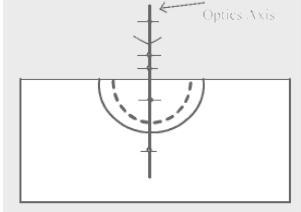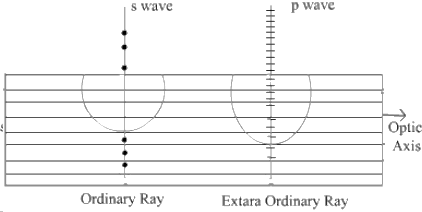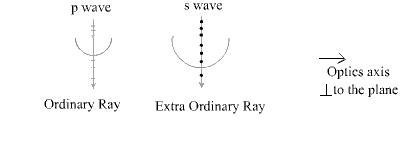SKEDSOFT
Propagation of light through birefringent crystal: Let us consider a uniaxial crystal placed in air. As discussed in the previous module, the radiation falling at an interface may be resolved in two kinds of polarization, viz: in plane polarization and perpendicular polarization. To make the discussion simple, we will consider the normal incidence only. If no> ne, the crystal is called as positive crystal and if no< ne, the crystal is called as negative crystal.
Case I:Let us consider the first case when the optics axis is perpendicular to the interface formed by the uniaxial crystal and the air as shown in Fig.1. In this case, the refractive indicies for both polarization is same and is given by no.
Both the s and p waves will travel with the same speed. One can show the wave front by drawing a circile of radius c/no with the center at the interface at point O, where the radiation is hitting the interface as shown in fig. The wave front will be spherical corresponding to both the components, . The situation will be similar to that of isotropic medium.

Fig.1 : Propagation of wave in uniaxial crystal when the optics axis is oriented along the direction of propagation
Case II . In the second case, the optics axis is parallel to the interface as shown in Fig 2 For the s wave (having polarization perpendicular to the plane of incidence or ![]() to the plane of the paper) the refractive index is no (and hence termed as ordinary wave) and the wave front will be spherical wave front as shown in fig 2. But for p wave the refractive index is ne (or it can be termed as extraordinary wave)and the wave front will be elliptical wave front. It can be drawn by plotting an ellipse with the major axis as c/ne along the direction of propagation and the minor axis as c/no along the optics axis. In this case, s and p wave will develop a relative phase difference while propagating the same length (physical ) in the crystal owing to different refractive indices.
to the plane of the paper) the refractive index is no (and hence termed as ordinary wave) and the wave front will be spherical wave front as shown in fig 2. But for p wave the refractive index is ne (or it can be termed as extraordinary wave)and the wave front will be elliptical wave front. It can be drawn by plotting an ellipse with the major axis as c/ne along the direction of propagation and the minor axis as c/no along the optics axis. In this case, s and p wave will develop a relative phase difference while propagating the same length (physical ) in the crystal owing to different refractive indices.

Fig 2. Prpoagation of plane wave in uniaxial crystal when optics axis is oriented parallel to the plane of the paper and perpendicular to the direcytion of propagation.
Case III . In this case the optics axis is perpendicular to the plane of the page. Optics axis is still parallel to the interface as in the case II. So in this case only difference is that s polarization is will see a refractive index ne and it will extraordinary wave and p polarization will observe refractive index no and will be ordinary ray as shown in fig 3.

Fig3. Propagation of plane wave in uniaxial crystal when optics axis is oriented perpendicular to the plane of paper as well as perpendicular to the direction of propagation.